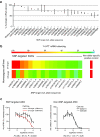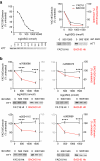Potent and selective antisense oligonucleotides targeting single-nucleotide polymorphisms in the Huntington disease gene / allele-specific silencing of mutant huntingtin
- PMID: 21971427
- PMCID: PMC3242664
- DOI: 10.1038/mt.2011.201
Potent and selective antisense oligonucleotides targeting single-nucleotide polymorphisms in the Huntington disease gene / allele-specific silencing of mutant huntingtin
Abstract
Huntington disease (HD) is an autosomal dominant neurodegenerative disorder caused by CAG-expansion in the huntingtin gene (HTT) that results in a toxic gain of function in the mutant huntingtin protein (mHTT). Reducing the expression of mHTT is therefore an attractive therapy for HD. However, wild-type HTT protein is essential for development and has critical roles in maintaining neuronal health. Therapies for HD that reduce wild-type HTT may therefore generate unintended negative consequences. We have identified single-nucleotide polymorphism (SNP) targets in the human HD population for the disease-specific targeting of the HTT gene. Using primary cells from patients with HD and the transgenic YAC18 and BACHD mouse lines, we developed antisense oligonucleotide (ASO) molecules that potently and selectively silence mHTT at both exonic and intronic SNP sites. Modification of these ASOs with S-constrained-ethyl (cET) motifs significantly improves potency while maintaining allele selectively in vitro. The developed ASO is potent and selective for mHTT in vivo after delivery to the mouse brain. We demonstrate that potent and selective allele-specific knockdown of the mHTT protein can be achieved at therapeutically relevant SNP sites using ASOs in vitro and in vivo.
Figures





References
-
- The Huntington Disease Collaborative Research Group A novel gene containing a trinucleotide repeat that is expanded and unstable on Huntington's disease chromosomes. Cell. 1993;72:971–983. - PubMed
-
- The Huntington Study Group Tetrabenazine as antichorea therapy in Huntington disease: a randomized controlled trial. Neurology. 2006;66:366–372. - PubMed
-
- De Marchi N, Daniele F., and, Ragone MA. Fluoxetine in the treatment of Huntington's disease. Psychopharmacology (Berl) 2001;153:264–266. - PubMed
-
- Zuccato C, Valenza M., and, Cattaneo E. Molecular mechanisms and potential therapeutical targets in Huntington's disease. Physiol Rev. 2010;90:905–981. - PubMed
Publication types
MeSH terms
Substances
Grants and funding
LinkOut - more resources
Full Text Sources
Other Literature Sources
Medical

